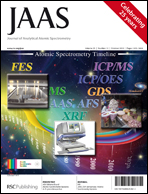Effects of non-uniformity of laser induced plasma on plasma temperature and concentrations determined by the Boltzmann plot method: implications from plasma modeling
Abstract
The validity of the popular Boltzmann plot method was theoretically tested for the case of a non-homogeneous non-isothermal laser-induced plasma. A collisional-dominated plasma model was employed to generate synthetic


 Please wait while we load your content...
Please wait while we load your content...